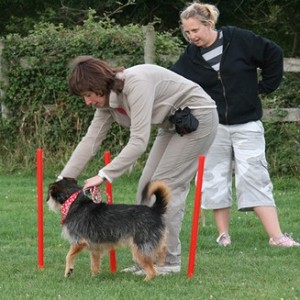 One of the things I say frequently about dogs and their owners is , “You can’t tell someone how to raise their child and you can’t tell them how to raise their dog.” Like politics or religion, a discussion about how to train or raise a dog can invoke strong emotions and strong opinions across a pretty wide spectrum. Everyone seems to have their preferred authorities and philosophies. You can express your own point of view but there is very real resistance to passing judgement on whose methods are more “right” or more “wrong” in polite society.
One of the things I say frequently about dogs and their owners is , “You can’t tell someone how to raise their child and you can’t tell them how to raise their dog.” Like politics or religion, a discussion about how to train or raise a dog can invoke strong emotions and strong opinions across a pretty wide spectrum. Everyone seems to have their preferred authorities and philosophies. You can express your own point of view but there is very real resistance to passing judgement on whose methods are more “right” or more “wrong” in polite society.
Most dog owners love their dogs very much and try to act in the best interests of keeping their dogs safe, well-adjusted, and happy. For some owners, that idea seems to contradict the use of shock collars, prong collars, and training methods based on “discipline” like the Koehler Method and Cesar Millan. For other owners, the idea seems to contradict the “food bribery”, “coddling”, and lack of “leadership” that positive trainers use with their dogs. And just like religion, it can be just as hard to know which approach works best for dogs as it would be to know for certain that there was one god, many gods, or none at all watching over us in the heavens. At a certain point, you just have to take it on faith.
The Black Box
In a very real way, we are playing a “guessing game” when it comes to what our dogs think. B.F. Skinner called it the “black box” into which we cannot see to know for certain. All we have to rely on is our dog’s behaviour and the changes in that behaviour as we do things. Our own human subjectivity and biases make the interpretation of that behaviour something less than precise. It seems the only way to know what we know about dogs comes about through trial and observation.
What we can observe from our dog’s behaviour is whether or not they are more or less likely to do (or not do) a particular behaviour. Whether that behaviour is barking at the mail carrier or sitting when we cue them, an observant owner can usually tell if their dog is performing more or less of the behaviour as things in the environment change. Skinner called this “reinforcement” (increasing behaviour) and “punishment” (decreasing behaviour). In effect, this should tell us whether changes we make in training our dogs are producing the desired effect by increasing or decreasing the targeted behaviour.
A Willingness To See
In his musical adventure “The Point”, songwrite Harry Nilsson introduces his protagonist, Oblio, to “The Rock Man” who tells him, “The thing is: you see what you want to see and you hear what you want to hear.” He goes on to ask Oblio, “Did you ever see Paris?” Oblio says no. “Did you ever see New Delhi?” Oblio again says no. And the Rock man replies “Well, that’s it. You see what you want to see and you hear what you want to hear.” Perhaps it might be a bit deep for a children’s story but I find a lot of truth in it. We are all free to ignore facts even if they are staring us in the face.
In researching this column each week, I come across some pretty interesting blog posts and articles. I truly believe that they are published by dog trainers who believe in what they are saying and have a genuine desire to make life better for dogs and their owners. What I find both stunning and perplexing are the lengths to which some people will go to ignore, re-interpret, or invalidate things that are easily proveable with a little effort.
Let me give you an example. If I want my dog to come when I call them and I give them a food treat when they do come back, do they come back fast, not as fast, or about the same as before I began offering the treat? I can measure that. If I stop offering them the treat after a while, what happens to that “come” behaviour? Does it become faster, less fast, or stay about the same? Again, this is totally measureable.
But here’s the thing, some trainers might think that using that food treat is “cheating” to get better behaviour. And so in spite of the proof that the method can work to get the desired behaviour, that trainer might go to some lengths to show me how, even though my dog is coming to me when called, I have created other “problems” in my dog by using food like “losing my dog’s respect”.
Shaking Bones and Burning Incense
 It seems to me that the more a trainer wants a particular outcome, the more willing they are to try anything in hopes of getting that result. This has been most apparent to me in the sport of dog agility where each weekend trial offers a smorgasbord of training techniques to get your dog to touch contacts, complete weave poles, and follow directions on the agility course. Unfortunately, many of these techniques seem to be too focused on getting the result without paying much attention to what the dog is actually learning.
It seems to me that the more a trainer wants a particular outcome, the more willing they are to try anything in hopes of getting that result. This has been most apparent to me in the sport of dog agility where each weekend trial offers a smorgasbord of training techniques to get your dog to touch contacts, complete weave poles, and follow directions on the agility course. Unfortunately, many of these techniques seem to be too focused on getting the result without paying much attention to what the dog is actually learning.
I once attended a seminar being presented by an agility instructor who had competed quite successfully in international competition. He made the point, in no uncertain terms, that agility dogs will watch their handler’s arms and will move in the direction indicated by the movement of the arms. Having had some experience at that point and, knowing that this did not seem to be true for my dog, I challenged the instructor on this point. With a condescending smirk and a roll of the eyes, I was told to attempt to run my dog through a prescribed sequence with my hands in my pockets so that I could not use my arms. When I completed the sequence without an error, not once but twice, the instructor muttered some explanation hastily moved on. I have no doubt that he continued to tell attendees at his seminars that the hander’s arms are critical to agility handling in spite of the fact that I had shown him at least one case where this was not true.
It seems that people frequentlly stumble upon training techniques that produce a particular result. The trouble is, once that result is obtained, many times there is no further investigation as to why that approach worked. Does it work with different dogs? Does it work with different breeds? Is there a particular element to that techniques that makes it work? Can that element be extended to other behaviours to get better results? It seems to me that this kind of exploration too often takes a back seat to showing anyone who will listen how to duplicate the method. Teaching them how to “shake the bones” and “burn the incense” to make the magic work.
Gurus and Mystics
This is where the “mysticism” comes into our discussion. How often do dog owners and trainers adopt a particular training technique or philosophy by taking it “on faith”? Maybe the technique came from a popular book or television program. Maybe it came from a trusted friend who has enjoyed a lot of success with her dogs. It may even have come from an “expert” in the dog community that has been invited to speak to a local dog group. But does it make rational sense and has it been appropriately tested?
If our dogs were inanimate objects or mindless bystanders, it might be appropriate to try anything and everything out on them until we find what works. But that’s not the case. Not only do our dogs have thoughts and feelings, they have memories. Every past experience we have had with our dog may influence, for good or ill, any new training or techniques we want to use. And that may have a serious impact on getting the behaviour we want.
It can seem that the sentiments Niccolo Machiavelli expressed in his book The Prince are prevalent in dog training today – “The ends justify the means.” Whatever we do in pursuit of our desired goals in training our dogs is fair game so long as it produces the behaviour we want. However, Machiavelli was talking about social systems in his book and not manipulating individuals. I would also like to believe that we have developed more accurate and sophisticated philosophies in the time since the 16th century when the book was written.
I’m going to go out on a limb here and say that it’s not alright to take techniques on “faith” before using them on our dogs. Just because some “expert” says that I can make my dog “stay” by jabbing her in the ribs if they move doesn’t mean it’s the best way to work with my dog. I also believe there’s a way to empirically determine if that’s true or not. And I believe that I owe it to my dog to make the effort to find out what my training alternatives are and which methods have proven to be the most effective with the least bad side effects.
Alternative training techniques and trendy appproaches to working with our dogs may sound attractive, especially if they promise quick and lasting results. There is a lot of money being made everyday by dog trainers making one promise or another. But when it comes to the health, safety, and well being of the dog you have taken into your home, it is up to you to decide what is best for them. For me that means doing some research to find the right approach and not just believing in what the popular gurus and trends are saying.
Until next time, keep doing the right things for your dogs!
Photo credits –
Moon – vanhap 2007 from Flickr
Dog Books – Earthworm 2009 from Flickr
Agility Training – Paranoid Black Jack 2008 from Flickr





“In a very real way, we are playing a “guessing game” when it comes to what our dogs think. B.F. Skinner called it the “black box” into which we cannot see to know for certain.”
When one realizes that Skinner offered this thesis as an explanatory model for human behavior, one can perhaps see the shortcomings in this philosophy. For Eric, this is a philosophy, and not, as you seem to suggest, a neutral statement of fact. .
To base one’s relationships with others on this radical skepticism is a philosophy that underpins the science of behaviorism. The philosophy itself – one of radical skepticism – is itself, not scientific but rather just one more faith. An anti-faith if you like.
It is not the use of food to get behavior that is the problem Eric, it is the philosophy – the radical skepticism – that informs the practice that other trainers object to.
Posting it on my Force Free Trainers Facebook group as well.
Thanks so much for reading Anne! I’m glad you found it a valuable read.
All the best,
Eric
Great article Eric! I am posting it on my “Observations for Training Dogs” Facebook group as the foundation of your article is about observations and filters that affect interpretation-tottally ON topic for my group! Thanks!
agreed!